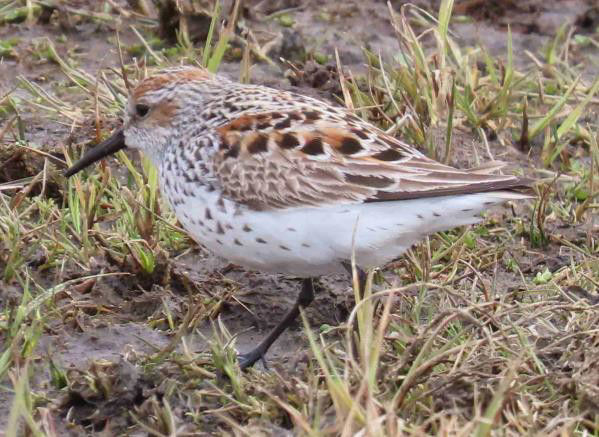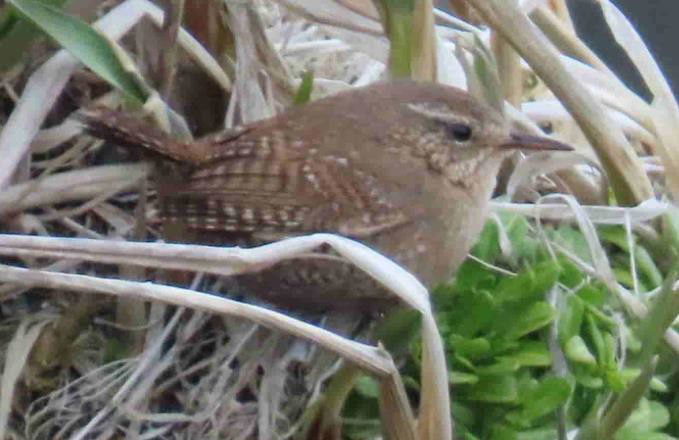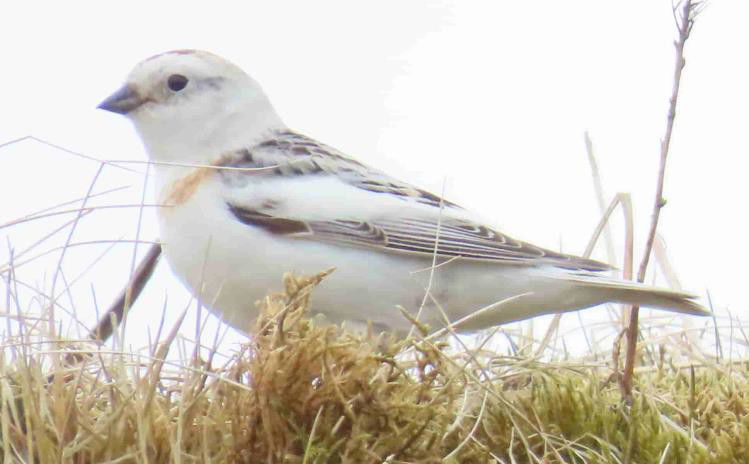Departure Date: May 21 - 27, 2025
Compiled By: Michelle Sopoliga
Trip Leaders: Michelle Sopoliga
Toll Free: 800.328.8368
Phone: 512.328.5221
Grand Alaska: Pribilofs & Anchorage 5/21/2025-5/27/2025

VENT’s summer birding in Alaska began this year with the Pribilofs & Anchorage Pre-Trip. We saw all of the target St. Paul Island breeders at close range plus a variety of bonus vagrants that were different from those we saw in 2023. It is so cool how every year is different for rarities. Our flights were on time, if not a little early, which was very nice. We spent three nights on St. Paul Island. Most of the time, the weather was good, with little to no precipitation or wind, except for one day. That just made the experience as authentic as possible, so we appreciated the lack of wind and cold rain on our last day that much more.
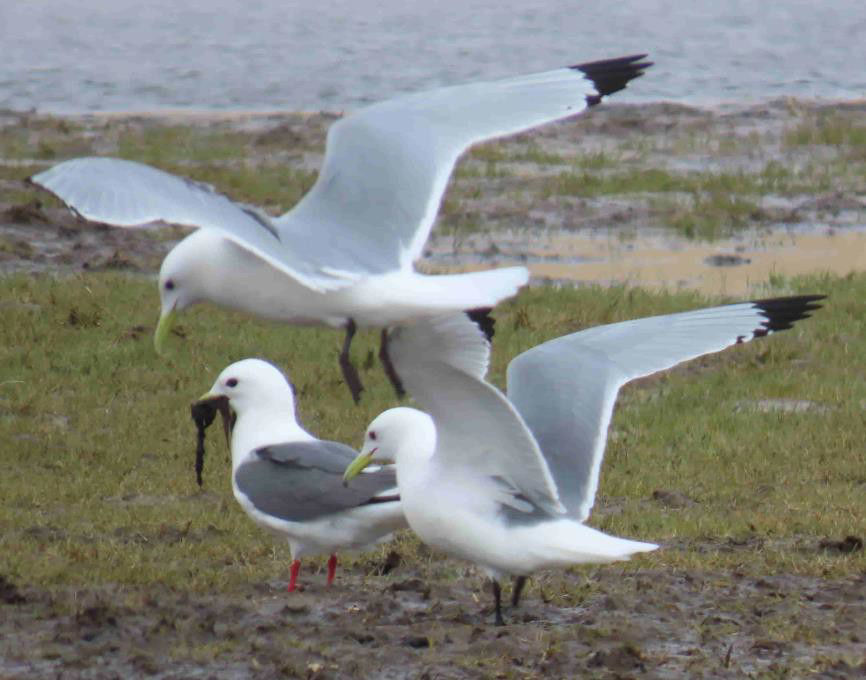
Red-legged and Black-legged Kittiwakes - by Michelle Sopoliga
After an introductory dinner in Anchorage, we walked over to Lake Hood to do a little birding. Right away, we got excellent looks at 3 Pectoral Sandpipers walking in the grass. Two Barrow’s Goldeneyes, 2 Redheads, 4 Red-necked Grebes, 1 Horned Grebe, and hundreds of Tree Swallows were the stars. The next day we lucked out, as we have with the past couple of trips, and experienced no weather-related delays on our way to the island. We enjoyed an uneventful three-hour flight, interrupted only by
the standard refueling stop in Bethel.
After arriving in St. Paul and settling into our rooms, we began our island birding adventure. St. Paul is famous for breeding seabirds and Asian vagrants, and we were about to begin checking them off our lists. We wound up having a three-stint day on our very first evening, which was an incredible introduction and welcome to the remote island in the middle of the Bering Sea.
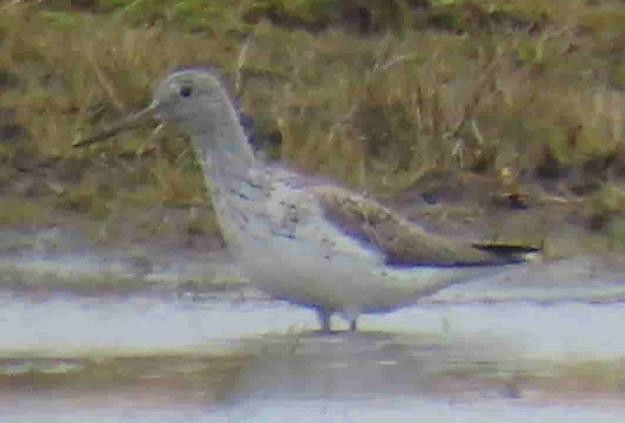
Common Greenshank, St. Paul Island - by Michelle Sopoliga
Our first stop was at Antone Slough, where a rare for the ABA Common Greenshank had been recently seen. Common Greenshanks are medium-sized shorebirds that are in the same genus as Greater and Lesser yellowlegs, which are common in North America. They look a lot like a Greater Yellowlegs, due to their relatively long and slightly upturned bill, but have more drab greenish-yellow legs and a cleaner white belly. A white wedge extending from their rump to the middle of their back is distinctive and can be easily seen in flight. The Greenshank was very cooperative, and we all got great looks (but not the best photos for some of us) at this Asian vagrant, both on the ground and in flight. Black-legged and Red-legged kittiwakes gathered nesting material around us the entire time. While at Antone Slough, we bumped into a few other shorebirds that are difficult to find in North America: Long-toed Stint and Wood Sandpiper. Other birds seen included close up looks at a Western Sandpiper, a rare for the Pribilofs Semipalmated Sandpiper, and Common Teal (the Eurasian subspecies of Green-winged Teal). An immature Bald Eagle circled overhead at one point, and a group of Sandhill Cranes were seen across the road from the slough and lake. Satisfied with good looks at good birds, we went back to the hotel for a nice warm meal.
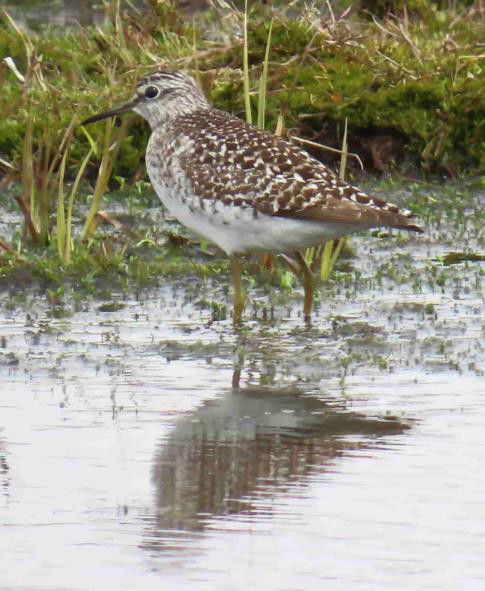
Wood Sandpiper, St. Paul Island - by Michelle Sopoliga
After dinner, we were driven out to the Marunich melt pond, at the north end of the island. There, we were treated to two more stints: an accommodating and very rare for North America Temminck’s Stint and the more common but still rare Red-necked Stint. To see three of the four stint species all in one day was a unique and wonderful experience. Stints are a group of small Calidris shorebirds, also known as “peeps.” Western and Northern Alaska, including Nome, Utqiagvik, the Pribilofs, Aleutians, and St. Lawrence Island are your best bet to see one in North America. We flushed up the Pribilof subspecies of Rock Sandpiper and Gray-crowned Rosy-Finch regularly during our drives around the island. Lapland Longspurs were also regularly displaying alongside the road, doing their parachuting descending flight as we went back to the hotel for a restful night of sleep.
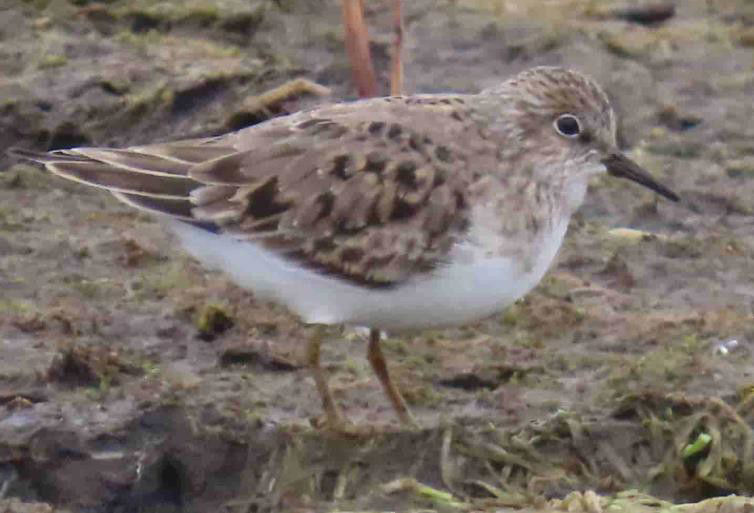
Temminck's Stint, St. Paul Island - by Michelle Sopoliga
The next day was our first full day on St. Paul. It was a beautiful but cold day with little to no wind and temperatures in the upper 30s F. We even got to experience some rare sunshine during the day! We started back at the Marunich melt ponds and were rewarded with looks at the Reindeer herd, better looks at the Temminck’s Stint, a Western Sandpiper, a Pectoral Sandpiper, a Least Sandpiper, and a Wandering Tattler. A Brambling was found along the beach, and all were able to get good looks at this lifer for most through the scope. A fly-by Long-tailed Jaeger in the distance ended up being our only jaeger of the tour. The Reindeer were still along the road on our drive back. They were introduced to the island for hunting and have established a herd of about 750–1,000 individuals. Reindeer are the domesticated and European version of North American wild Caribou.
One of the highlights of every trip to St. Paul is seeing the breeding colonies of a variety of seabirds. We made a stop at East Landing and Reef Point and were not disappointed. We were able to get almost eye level views of Parakeet and Least auklets, Red-faced Cormorants, Tufted Puffins, Horned Puffins, Thick-billed and Common murres, and Red-legged and Black-legged kittiwakes. An Arctic Fox and Glaucous-winged Gull sat on the rocks along the shoreline. We stopped by the Seal Blind and were treated with views of a few Northern Fur Seals that were hauled out on the rocks. Ancient Murrelets bobbed in the waves, along with our only island Red-necked Grebe.
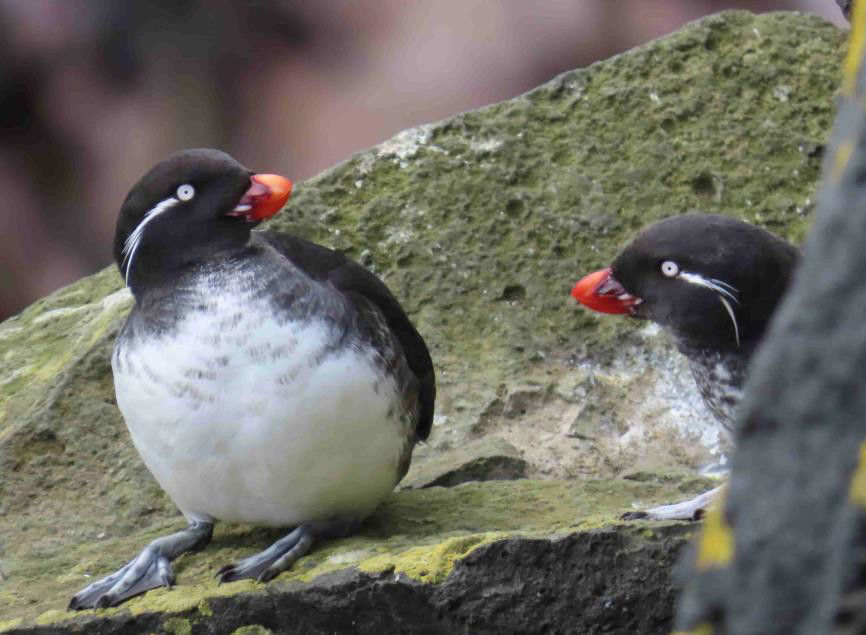
Parakeet Auklets, St. Paul Island - by Michelle Sopoliga
We went over to the harbor after lunch with one of my high school students, Zoe, who recently moved back to St. Paul after living in Fairbanks. She told us about life on St. Paul and about how important the seals and other wildlife are for the indigenous Unangax̂ community. She showed us a live sea urchin, which was really cool to see up close. At the harbor, we saw a Snow Bunting, a singing Pacific Wren, King Eiders, Harlequin Ducks, a Black Scoter, Bufflehead, and Long-tailed Ducks. Blue phase Arctic Foxes were running around and allowed us to take some photos. Along the mudflats, we saw a Whimbrel walking around with the Rock Sandpipers. A Short-eared Owl flushed up and circled around from the grass behind the crab pots for a few minutes before disappearing behind the dunes.
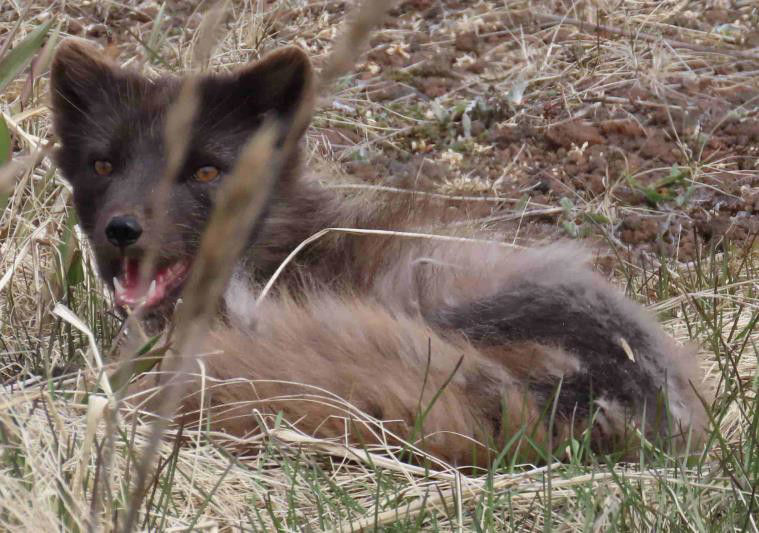
Arctic Fox, St. Paul Island - by Michelle Sopoliga
We then decided to walk the shorelines of Cup and Saucer, and Pumphouse Lake, since they have produced some really good vagrants in the past. We found our first Eurasian Wigeon of the trip, American Wigeon, Red-necked Phalaropes, Northern Pintails, Eurasian (also known as Common) and American subspecies of Green-winged Teal, and a continuing Long-toed Stint. We tried to turn a few Lapland Longspurs into recently reported Red-throated Pipits but were unsuccessful. After dinner, we tried to flush something rare from the crab pots but found only a Semipalmated Sandpiper. Hanging out with some Greater Scaup, we got to see our first female Tufted Duck of the trip on our ride back to the hotel for another good night of sleep.
The weather the following morning gave us a taste of what an island in the middle of the Bering Sea can do. The blustery, cold wind and rain made birding difficult, but luckily it cleared up, the wind died down, and birding was quite pleasant again by the evening. We attempted to check out the Ridge Wall Cliffs to start, but our optics and glasses were difficult to see through with the persistent rain and wind; we were practically blown off the cliffs! Just kidding. We were, however, just barely able to glimpse the wall of Common and Thick-billed murres, Northern Fulmars, Red-legged and Black-legged kittiwakes, Horned and Tufted puffins, and Least, Parakeet, and a couple of Crested auklets before we decided that we had had enough of the wind and rain and took shelter in the van. Southwest Point didn’t provide much more shelter from the elements, but we did see our first and only Emperor Goose of the trip. By the time we had driven over to Kaminista Quarry, the rain and wind had slowed down. There, we walked through a collapsed lava tube and were surrounded and sung to by Snow Buntings, Gray-crowned Rosy-Finches, and Pacific Wrens.
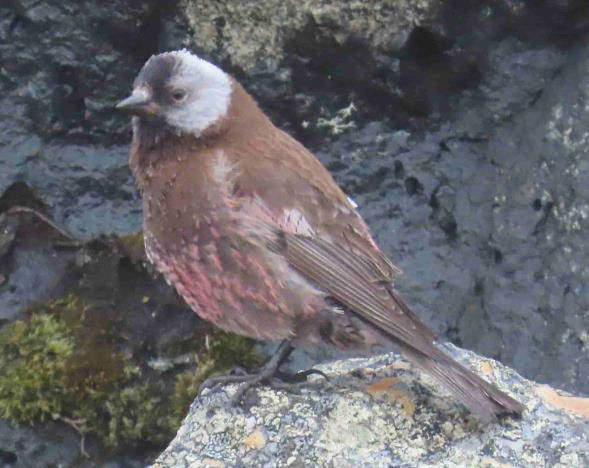
Pribilof subspecies of Gray-crowned Rosy-Finch, St. Paul Island - by Michelle Sopoliga
With the weather clearing and a nice warm lunch in our stomachs, we made the drive out to Big Lake, Webster Lake, and Hutchinson Hill. The continuing Tundra Swans, Snow Goose, and two pairs of Tufted Ducks cooperated and allowed us good looks. We flushed up an adult breeding plumage male Brambling at Hutchinson Hill. On our drive back, a tan passerine flushed up off the side of the road and excitement broke out . . . it was the first Hawfinch of the tour! We chased it around on the dunes near Webster Lake but never got good looks at it other than glimpses of it in flight. The white wing patches were unmistakable. We had to head back to the hotel for dinner but hoped that it might end up at the Hutchinson Hill feeder. The other group did end up seeing one on the feeder later that evening, and we saw it really well the next morning. After dinner, we made a quick trip over to the harbor to see the Eurasian subspecies of Common Merganser, also called a Goosander. We also saw our first Dunlin of the trip before calling it a night.
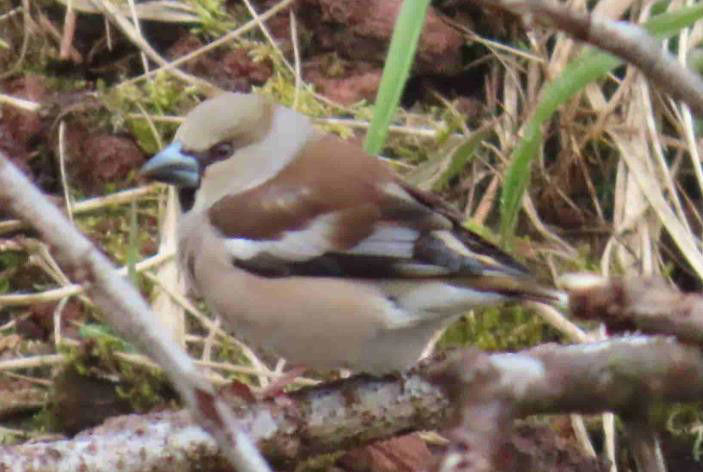
Hawfinch, St. Paul Island - by Michelle Sopoliga
The last day on the island was ahead of us, and we decided to check the feeder at Hutchinson Hill in hopes of getting better looks at the Hawfinch that was seen there by the other group the previous night. We pulled up to the feeder and were rewarded almost immediately after getting out of the van. The Hawfinch landed on the road behind the van and made its way back to the feeder, allowing all of us really good looks at this beautiful Asian vagrant. Satisfied with our Hawfinch experience, we made our way back to the Ridge Wall in hopes of a better look at roosting seabirds than we had the previous day. We found an immature Glaucous Gull along the way, which was a nice change from the common Glaucous-winged Gulls that we had been seeing daily. It was a wonderful choice, allowing all of us amazing quality views of all of the birds that we had struggled to view in the wind and rain. A quick drive through the Kaminista Quarry didn’t reveal anything new, so we made our way back to the hotel and checked in for our flight back to Anchorage. While waiting for the plane, we walked around the hotel and found one more Hawfinch. Our flight back to Anchorage got us back a little early.
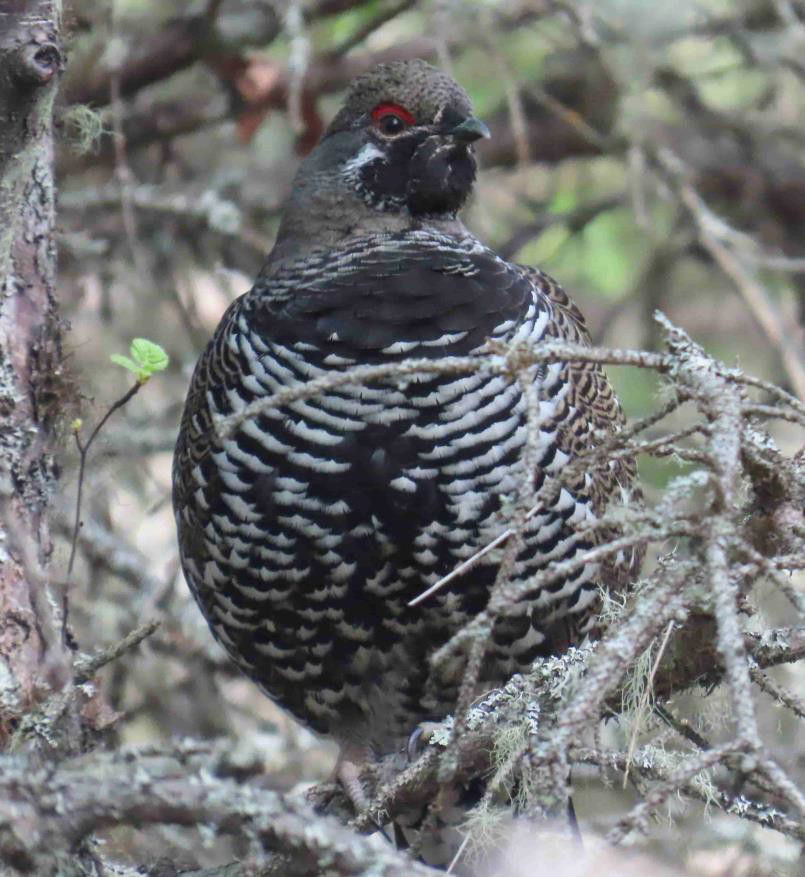
Spruce Grouse, Anchorage - by Michelle Sopoliga
We had only one day in Anchorage to look for boreal species, but we made the most of it and were able to get on three of our four main targets: Spruce Grouse, Three-toed Woodpecker, and Hudsonian Godwit. We were unable to locate a Black-backed Woodpecker, but the quality of views of the other three species certainly made up for it.
We started the day at the Audubon Bench on the coast to look for Hudsonian Godwits. We were unable to find any, but we did get to see Blue-winged Teal, Gadwall, Arctic Tern, Bonaparte’s and Short-billed gulls, Sandhill Cranes, a distant Red-throated Loon, a Steller’s Jay, and lots of other common local birds.
In Kincaid Park we walked the Mize Loop Trail. It started off slow but heated up after finding some Golden-crowned Kinglets. We rounded a bend and were able to find an American Three-toed Woodpecker drumming on top of a dead tree. A little further down the trail, Kathy noticed a Spruce Grouse in the underbrush. As we continued along the trail, listening to Swainson’s and Hermit thrushes and Myrtle’s Yellow-rumped and Orange-crowned warblers, all of a sudden there was a crunch in the brush just off the trail. Just around the bend, we saw a Moose cow with a very young calf. We watched carefully to ensure that we didn’t bother her too much, because Moose cows are known to attack people who get too close to their calves. All of a sudden, we watched as a Black Bear walked toward them. The Moose turned around and chased the bear up a tree. That was a bit nerve-wrecking, but a super-cool experience! We decided to walk back the way we came instead of continuing past the agitated Moose and bear.
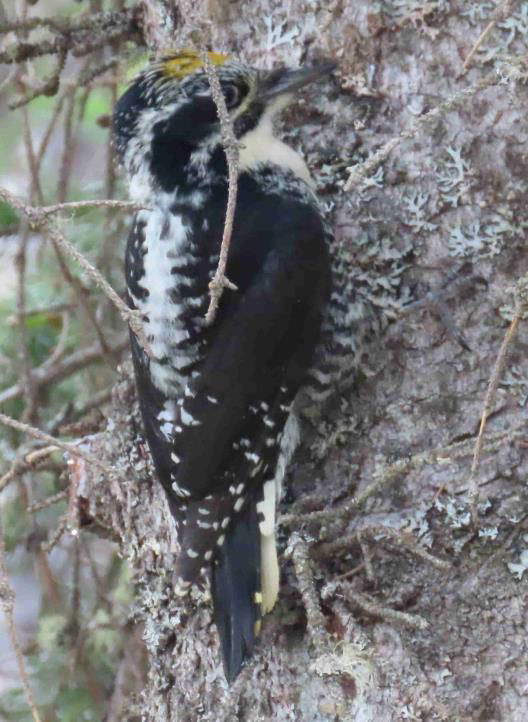
American Three-toed Woodpecker, Anchorage - by Michelle Sopoliga
After a morning of excitement, we made our way uphill to Hilltop Ski area. There, we got good looks at Bald Eagles, American Three-toed Woodpecker, Slate-colored Dark-eyed Junco, Gambel’s White-crowned Sparrow, Ruby-crowned Kinglets, and Violet-green Swallows.
Continuing along, we went to Potter’s Marsh, where we were entertained by some Trumpeter Swans, Arctic Terns, Red-throated Loons, and a Northern Waterthrush. With only a little time left before dinner, we made one last attempt at Hudsonian Godwits at Arctic Audubon Bench and Westchester Lagoon and were not disappointed. At least five of them swooped and chased each other around as we watched in delight.
Whimbrel, Dowitchers, a Surfbird, a Belted Kingfisher, and a White-winged Scoter were the last birds of our trip. Our tour concluded after an amazing dinner at Orso in Anchorage.
This tour provided us with a truly remote Pribilof Island and not-as-remote boreal forest Alaskan experience. Thank you to our St. Paul Island guides Sulli Gibson, Luis Gles, David Jadhon, and Mariah Hryniewich for helping us see what St. Paul Island has to offer. Thanks also to Kevin Zimmer for giving me this opportunity and support along the way. A very special thanks goes to the group of wonderful participants who I got to guide for my second tour. I am very grateful for everyone’s enthusiasm, patience, and help as I continue to learn how to make everyone’s experience as enjoyable and fulfilling as possible.
Read the description for the next departure of this tour.
View Michelle Sopoliga's upcoming tour schedule.
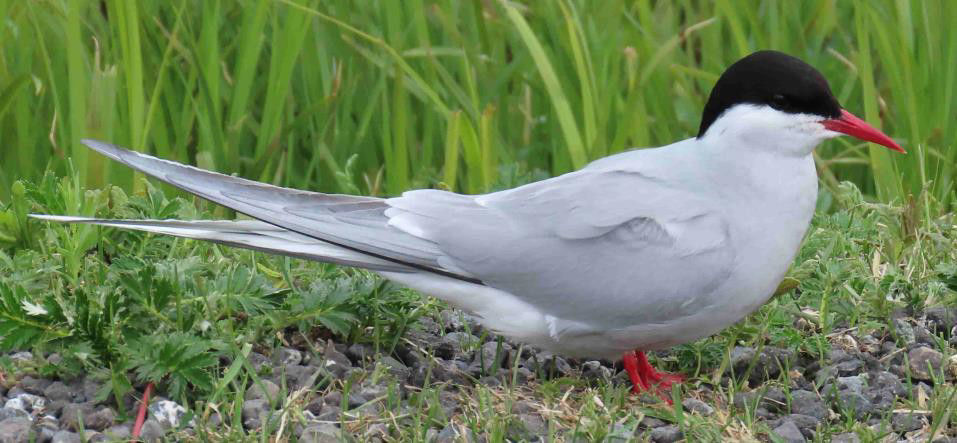
Arctic Tern, Anchorage - by Michelle Sopoliga
ITINERARY
5/21 - Met at 1830h in Anchorage for dinner at Coast Inn at Lake Hood. Birded at Lake Hood for about 30 minutes after dinner.
5/22 - Anchorage to St. Paul: breakfast at hotel at 0600h, shuttle transfer at 0745h, to check in for our Ravn Air flight to the Pribilofs. Arrived on schedule at 1430h, check in to our rooms at the King Eider Hotel, and then a check of Antone Slough; dinner; Marunich melt pond. Night in St. Paul.
5/23 - St. Paul Island, the Pribilofs: breakfast at 0700h, depart 0800h for birding at Marunich, East Landing, Reef Cliffs, Seal Blind; lunch from 1200h–1300h; afternoon birding with high school student & local resident, Zoe, at Harbor, Cup & Saucer, Pumphouse Lake; dinner at 1700h. Night in St. Paul.
5/24 - St. Paul Island, the Pribilofs: breakfast at 0700h, depart 0800h for birding at Ridge Wall Cliffs, Southwest Point, Kaminista Quarry; lunch from 1200h–1300h; afternoon birding at Barbara Lake, Big Lake, Webster Lake, Hutchinson Hill; dinner at 1700h. Night in St. Paul.
5/25 - St. Paul Island, the Pribilofs: breakfast at 0700h, depart 0800h for birding at Hutchinson Hill Feeder, Webster Lake, Ridge Wall, and Kaminista Quarry; 1200h lunch and check-in for our return flight to Anchorage, flight back to Anchorage arrived early about 1830h. Dinner and night at the Coast Inn at Lake Hood, Anchorage.
5/26 - Anchorage: breakfast 0600h at hotel, with 0700h departure for morning birding at Audubon Bench, Kincaid Park, Hilltop Ski Area, Potter’s Marsh, lunch at Bagels and Brews; Westchester Lagoon, Audubon Bench; Pribilofs & Anchorage Pre-Trip officially ends after a really nice dinner at Orso. Nome & Gambell main tour kicks off in the morning with a very early morning flight.
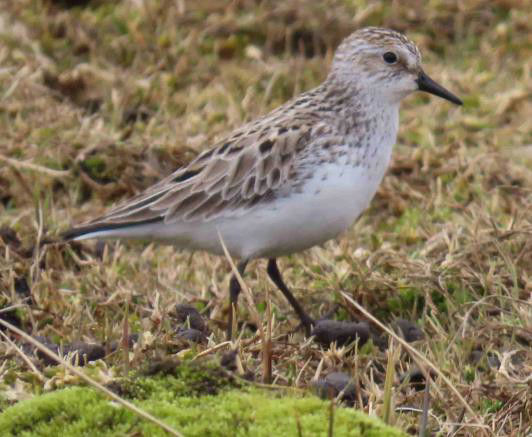
Semipalmated Sandpiper, St. Paul Island - by Michelle Sopoliga
KEY
A = Anchorage area (Audubon Bench, Kincaid Park, Hilltop Ski Area, Potter’s Marsh, Westchester Lagoon and Lake Hood/Spenard next to our hotel.)
P = St. Paul Island, the Pribilofs
* = vagrant

